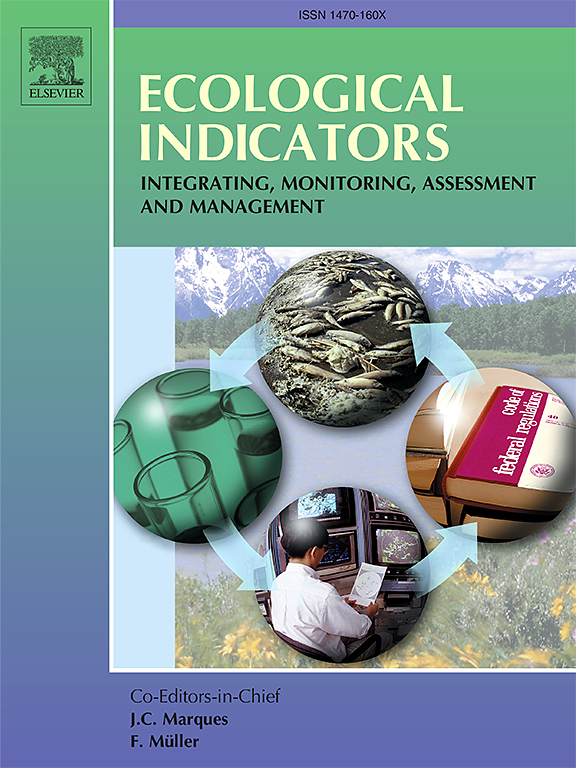土壤保持服务的实际供给限制了它们的利用:从生态系统服务流的角度
IF 7
2区 环境科学与生态学
Q1 ENVIRONMENTAL SCIENCES
引用次数: 0
摘要
土壤保持服务(SCS)是生态系统调节服务的一个重要组成部分,在缓解区域土地退化和减少洪水灾害风险方面发挥着关键作用,已经引起了学术界的广泛关注。然而,天然气供需之间仍然存在明显的不匹配,因此需要更深入地了解天然气是如何从供应地区流向需求地区的。尽管其重要性,但对南海流动动态的研究仍然不发达,限制了其为可持续生态系统管理的知情和细致决策提供强有力支持的能力。为了弥补这一研究空白,本研究以荆河流域为研究对象,利用SWAT和GIS技术对南海的时空格局进行了再现。此外,本研究还定量评估和绘制了4个不同空间尺度的减沙服务流量和路径,旨在阐明JRB内南海流的空间传递机制。最后,本研究基于供需-流量-使用(SDFU)框架,通过计算南海流的实际供给和潜在需求,量化南海流的实际使用情况,重点分析南海流实际使用的局限性。研究结果表明:(1)南海供需高、低值的空间分布格局具有显著的一致性,且南海供需高、低值在时间上呈现出初始快速上升后趋于稳定的特征。(2)在水柱沉积物的促进下,南海在流域网络内通过坡面、河流和子流域进行空间位移,2000年降沙服务流量达到最低点,2010年显著增加,2020年略有下降。(3)从2000年到2020年,SCS的实际使用与SCS的流量趋势相似,需求满意率稳步上升(0.22,0.34,0.77),表明SCS的实际供应虽然满足了更多的需求,但仍不能完全满足实际使用。综上所述,本研究的尝试不仅丰富了生态系统服务流的研究领域,而且有望为土地资源的科学管理和区域可持续发展提供理论指导。本文章由计算机程序翻译,如有差异,请以英文原文为准。
Actual supply of soil conservation services limits their use: From an ecosystem service flow perspective
Soil conservation services (SCS) represent a vital subset of ecosystem regulating services, playing a critical role in mitigating regional land degradation and reducing flood disaster risks, a subject that has garnered considerable scholarly attention. Nevertheless, a significant mismatch persists between SCS supply and demand, highlighting the need for a deeper understanding of how SCS flows operate from supply areas to demand areas. Despite its importance, research on the dynamics of SCS flows remains underdeveloped, limiting its ability to provide robust support for informed and nuanced decision-making in sustainable ecosystem management. To address this research gap, this study conducted an investigation in the Jinghe River Basin (JRB), utilizing SWAT and GIS technologies to reproduce the spatiotemporal patterns of SCS. Additionally, this study quantitatively assessed and mapped the sediment reduction service flow volumes and pathways at four different spatial scales, aiming to elucidate the spatial transfer mechanisms of SCS flow within the JRB. Finally, based on the supply–demand-flow-use (SDFU) framework, this study quantifies the actual use of SCS flow by calculating its actual supply and potential demand, with a focus on analyzing the limitations to its actual use. The findings of this research yield several critical insights: (1) The spatial distribution patterns of high and low values in SCS supply and demand within the JRB exhibited significant congruence, while both components manifested a consistent temporal trajectory characterized by rapid initial escalation followed by subsequent stabilization. (2) The transport of SCS, facilitated by sediments in the water column, undergoes spatial displacement through slopes, rivers, and subbasins within the watershed network, with the flow volume of sediment reduction services reaching its nadir in 2000, increasing significantly in 2010, and slightly declining in 2020. (3) From 2000 to 2020, the actual use of SCS followed a similar trend to SCS flow, with the demand satisfaction rate steadily increasing (0.22, 0.34, 0.77), indicating that while the actual supply of SCS is meeting more demand, it still fails to fully satisfy the actual use. In summary, the attempt of this study not only enriches the research field of ecosystem service flow but also promises to provide theoretical guidance for the scientific management of land resources and sustainable regional development.
求助全文
通过发布文献求助,成功后即可免费获取论文全文。
去求助
来源期刊

Ecological Indicators
环境科学-环境科学
CiteScore
11.80
自引率
8.70%
发文量
1163
审稿时长
78 days
期刊介绍:
The ultimate aim of Ecological Indicators is to integrate the monitoring and assessment of ecological and environmental indicators with management practices. The journal provides a forum for the discussion of the applied scientific development and review of traditional indicator approaches as well as for theoretical, modelling and quantitative applications such as index development. Research into the following areas will be published.
• All aspects of ecological and environmental indicators and indices.
• New indicators, and new approaches and methods for indicator development, testing and use.
• Development and modelling of indices, e.g. application of indicator suites across multiple scales and resources.
• Analysis and research of resource, system- and scale-specific indicators.
• Methods for integration of social and other valuation metrics for the production of scientifically rigorous and politically-relevant assessments using indicator-based monitoring and assessment programs.
• How research indicators can be transformed into direct application for management purposes.
• Broader assessment objectives and methods, e.g. biodiversity, biological integrity, and sustainability, through the use of indicators.
• Resource-specific indicators such as landscape, agroecosystems, forests, wetlands, etc.
 求助内容:
求助内容: 应助结果提醒方式:
应助结果提醒方式:


